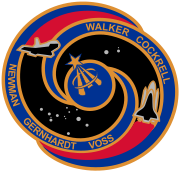STS-69

STS-69 launches from Kennedy Space Center, 7 September 1995
|
|||||
| Mission type | Research | ||||
|---|---|---|---|---|---|
| Operator | NASA | ||||
| COSPAR ID | 1995-048A | ||||
| SATCAT № | 23667 | ||||
| Mission duration | 10 days, 20 hours, 29 minutes, 56 seconds | ||||
| Distance travelled | 7,200,000 kilometres (4,500,000 mi) | ||||
| Orbits completed | 171 | ||||
| Spacecraft properties | |||||
| Spacecraft | Space Shuttle Endeavour | ||||
| Payload mass | 11,499 kg (25,351 lb) | ||||
| Crew | |||||
| Crew size | 5 | ||||
| Members |
David M. Walker Kenneth Cockrell James S. Voss James H. Newman Michael L. Gernhardt |
||||
| Start of mission | |||||
| Launch date | 7 September 1995, 15:09:00 UTC | ||||
| Launch site | Kennedy LC-39A | ||||
| End of mission | |||||
| Landing date | 18 September 1995, 11:38:56 UTC | ||||
| Landing site | Kennedy SLF Runway 33 | ||||
| Orbital parameters | |||||
| Reference system | Geocentric | ||||
| Regime | Low Earth | ||||
| Perigee | 321 kilometres (199 mi) | ||||
| Apogee | 321 kilometres (199 mi) | ||||
| Inclination | 28.4 degrees | ||||
| Period | 91.4 min | ||||
|
|
|||||


Left to right - Seated: Cockrell, Walker; Standing: Gernhardt Newman, Voss
STS-69 was a Space Shuttle Endeavour mission, and the second flight of the Wake Shield Facility (WSF). The mission launched from Kennedy Space Center, Florida on 7 September 1995. It was the 100th successful manned NASA spaceflight, not including X-15 flights.
The 11-day mission was the second flight of the Wake Shield Facility (WSF), a saucer-shaped satellite that was to fly free of the Shuttle for several days. The purpose of the WSF was to grow thin films in a near perfect vacuum created by the wake of the satellite as it moved through space. The crew also deployed and retrieved the Spartan 201 astronomy satellite, performed a six-hour spacewalk to test assembly techniques for the international Space Station and tested thermal improvements made to spacesuits used during space walks.
The Spartan 201 free-flyer made its third flight aboard the Shuttle. The Spartan 201 mission was a scientific research effort aimed at the investigation of the interaction between the Sun and its outflowing wind of charged particles. Spartan's goal was to study the outer atmosphere of the Sun and its transition into the solar wind that constantly flows past the Earth.
...
Wikipedia
